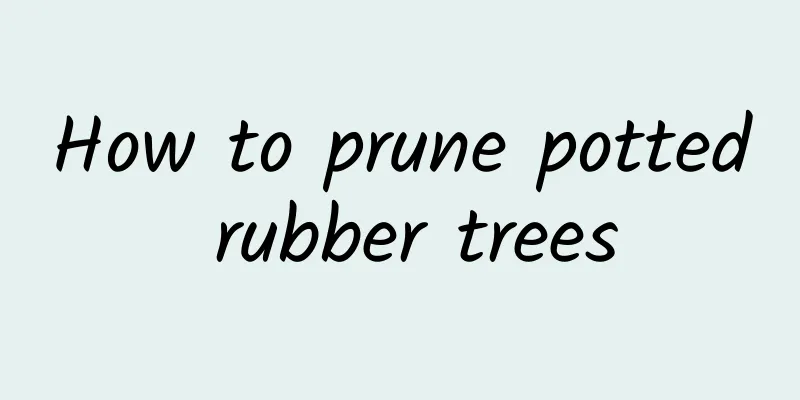How to prune potted rubber trees

Pruning time for potted rubber treesTheoretically, as long as the climate is suitable, potted rubber trees can be pruned all year round. However, the correct way is to pinch or thin out the trees in spring, cut side branches in summer, and avoid heavy pruning in winter. Prune yellow or diseased leaves in time. Do not prune during the rainy season because the wounds will be easily infected by bacteria due to the high humidity. How to prune potted rubber trees1. Topping When the potted rubber tree grows to 60 cm in height, you can start to pinch the top of the tree. Use scissors to cut off the top branches and buds 40 cm above the ground, and allow it to sprout new side branches 2-3 side buds below the top. This will allow it to grow horizontally and prevent the plant from being too tall. 2. Shorten Potted rubber trees can be pruned in spring by cutting off the slower growing side branches, allowing the rubber tree to sprout new branches at the side bud position. Pruning may affect the appearance at the time, but it is beneficial to the growth of the rubber tree. The sprouting of new branches mainly depends on such means. 3. Thinning Potted rubber trees grow vigorously in the summer, and their branches and leaves may become dense, affecting the light transmittance between the branches and leaves, and making diseased and weak branches more likely to appear. At this time, you can use scissors to cut off the dense branches, old branches among the crossed branches, and weak branches to make the branches and leaves sparse and orderly. 4. Bud carving If there are fewer branches and leaves on the main branches of the potted rubber tree, you can make it sprout more side buds by carving buds. In April, use a knife to make 1-2 horizontal wounds 1 cm above the place where you want to promote budding. New buds will sprout below in about 20 days, and after a while, 3-4 side branches will grow out. 5. Support buds If a potted rubber tree grows too many side buds, it will consume more nutrients, thus affecting the growth of the main trunk and the overall appearance. Therefore, when there are many side branches, you can break off the newly sprouted side buds to concentrate the nutrients on the growth of the main trunk, thereby promoting its overall appearance. |
<<: How to deal with dahlias after they bloom
>>: How to deal with gladiolus after flowering
Recommend
How to Overwinter Boxwood in Winter
Reasonable maintenance of boxwood Reasonable main...
Is goldfish flower suitable for large or small pots?
Should I use a large or small pot for goldfish fl...
When does Strelitzia reginae bloom?
Strelitzia flowering period The flowering period ...
Why is dahlia called Tianma flower?
1. Reasons First of all, dahlia is not Gastrodia ...
This kind of "yellow bitter melon" used to be everywhere, but now it is not sold. It tastes "sweet" and delicious!
This fruit looks like bitter melon, but unlike bi...
How to trim coleus
When to mow coleus There are three time periods t...
Where is the best place to plant jasmine?
Sunny place Jasmine is a very positive flower pla...
Where is the best place to plant burdock?
Burdock Growing Conditions Burdock is a light-lov...
How to care for orchids after replanting with empty roots
1. Maintenance after replanting 1. Water: After r...
The Flower Language and Legend of Elderberry
Flower language of elderberry The flower language...
How to plant kapok trees? Can seeds be planted?
1. How to plant kapok trees 1. Land preparation a...
When is the best time to repot jade plants?
Jade tree repotting time Generally, a newly purch...
The language of the moss phlox and the origin of its name
The language of the moss phlox and the origin of ...
Can August melon be planted in the north? Planting climate conditions
Planting wax gourd in the north Wax melon can be ...
What is the difference between ginkgo and almonds?
1. Different tree species Ginkgo is the fruit gro...









